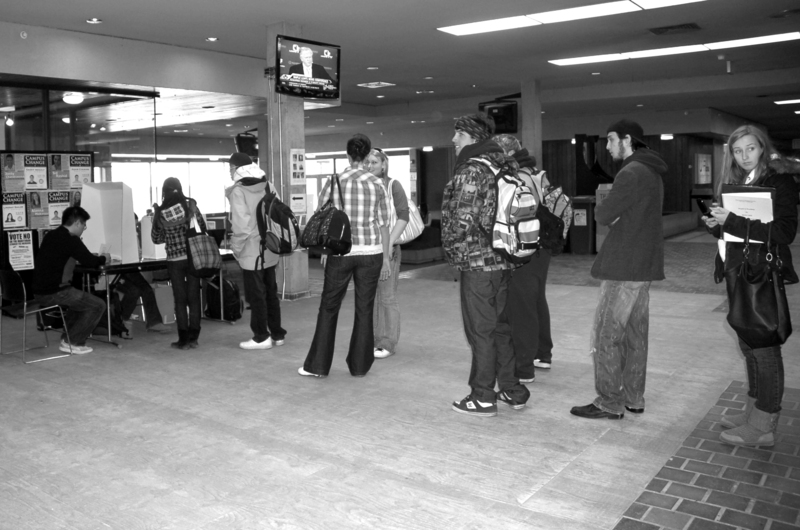The Manitoban broke this story last Friday Nov. 14 and will continue to update over the course of development.
The University of Manitoba administration has instructed faculties and other non-academic units to prepare for four per cent budget cuts for each of the next two years.
According to U of M president David Barnard, the proposed cuts are contingent on how much the provincial government increases its annual operating grant for Manitoba universities.
The provincial government increased the annual operating grant for all universities in the province by 2.5 per cent in their March budget for 2014-2015, surprising post-secondary institutions that were preparing for an increase of zero.
As a result, the U of M is drafting its 2015-2016 budget in anticipation of either a 2.5 per cent increase or an increase of zero.
All units are being asked to prepare and make recommendations for a three per cent budget cut if the operating grant increases at the same rate as 2014, or four per cent if the operating grant remains stagnant.
All units are also being asked to prepare for average budget cuts of four per cent for the 2016-2017 academic year.
“Those will not be easy adjustments for anyone, I think everybody is doing good work with the resources they’ve got,” Barnard told the Manitoban.
“The question really is: what would you do to make a difference if you had to make a difference?”
According to Barnard, the cuts are necessary given that the U of M faces a budget shortfall of $10.5 million even if the operating grant increases by 2.5 per cent this year. The grant makes up 56 per cent of the U of M’s operating budget.
“This university is funded on a per student basis on average below what the average university that looks like us is funded at,” Barnard said, adding that the aggregate amount of tuition fees coupled with the provincial government’s annual operating grant is too low to sustain current university expenditures.
“It’s low in large measure because of tuition fees being much lower than they are in the country [ . . . ] if they moved up to be comparable to fees at other universities it would mean a substantial increase in revenues for the university.”
According to Barnard, the University of Saskatchewan (U of S) is an example of an institution that receives more in tuition fees than the U of M but still remains affordable compared to the national average. If the U of M received the same tuition fees on a program-by-program basis as the U of S, it would have access to over $40 million in additional revenue annually, Barnard said.
Following a decrease in tuition fees in 1999 and 2000 and a decade of tuition freezes in Manitoba, the provincial government allowed universities to raise tuition by up to 4.5 per cent in 2009 and up to five per cent in 2010.
In 2011, the provincial government capped tuition fees at the rate of inflation, where they have remained since. The province initially promised to raise the operating grant for universities by five per cent a year for three years after 2011 to account for low tuition, but the government reneged in the final year. In the 2013 budget, the government increased the operating grant by only 2.5 per cent, increasing it by the same rate again this year.
Students and faculty respond
Students and faculty members are questioning whether the cuts are fully justified and whether the level of transparency in the university’s budget process is sufficient.
“In general, students aren’t consulted in any way when it comes to where budgets are going [ . . . ] right now that’s non-existent,” said Kaitlyn Gibson, a fourth-year global political economy student at the U of M.
“Our tuition rises every year. How is that being allocated and is our administration working in the most efficient way?”
Gibson continued, “We need to be talking to them and there needs to be an understanding of what the issues are and they should know that students are concerned and that they do want to be part of this.”
Along with several other students and faculty members, Gibson has organized a public assembly to be held on Nov. 26. The assembly will act as a means of organizing resistance to the impending cuts while also seeking more information about the budget process.
Robert Chernomas, a U of M economics professor critical of the proposed cuts, is slated to speak at the assembly.
Chernomas argues that the university’s claims of a funding crunch are misleading. He claims that the U of M is spending millions in administrative costs, including through communications and marketing, that should be allocated to faculty and other academic areas.
“They are making choices that may not be consistent with the interest of students, professors, and staff at the University of Manitoba and so what we want to be able to do is make those decisions transparent,” he said, conceding that the U of M did experience a decrease in its expected operating grant.
“They are still playing with an awful lot of money that they are using for other purposes that could make it possible not to have cuts to faculty and instead continue funding students, graduate students, libraries so we don’t have fewer courses or larger class sizes.”
The Canadian Federation of Students-Manitoba (CFS-MB) passed a motion at their Nov. 6 provincial executive meeting that repudiated the proposed budget cuts at the U of M. The motion also vowed that the CFS-MB will lobby the provincial government to increase funding for post-secondary education in next year’s budget.
Zach Fleisher, CFS-MB chairperson, is particularly critical of the university’s early budget process, known as the strategic resource allocation process.
“The university budget isn’t transparent and it isn’t accessible and it’s unclear how these decisions are made,” Fleisher said.
“To my understanding, students aren’t bringing these concerns up and if their elected student representatives are privy to this and have a say on this, they aren’t making it known.”
Al Turnbull, University of Manitoba Students’ Union president, has known that the U of M was preparing for cuts over the last year and a half.
Turnbull sits on the senate strategic planning committee and is a member of the university’s board of governors. He argues that the U of M is faced with difficult choices given the funding outlook from the provincial government and that UMSU is committed to lobbying the government for more stable funding in anticipation of the 2015 provincial election.
“This is in many ways a dark time for the university, where they can’t make any moves to raise tuition and they haven’t been given the amount that has been promised them from the province,” Turnbull said, adding that the U of M was making long-term projections on the basis of larger and more steady funding increases from the provincial government.
“When there’s no money you can’t make any perfect decisions [ . . . ] I’m in all the meetings and I have a fairly good understanding of the situation right now that the university is in and it isn’t good and it hasn’t been good for a year and a half.”
Laura Rempel, president of the U of M Graduate Students’ Association, is concerned that the proposed cuts may have an impact on graduate programs. She sits on the university’s board of governors and has been aware of potential cuts since May.
“I think it would be difficult to maintain a high quality of education in this current climate of austerity measures,” she said, adding that more information is needed on the potential impact of the cuts.
“There is money around but I think it is a matter of prioritization and how the money will be distributed [ . . . ] I think that there will be some strategic prioritization of [graduate] programs in the next little while.”
University of Manitoba Faculty Association vice-president Mark Hudson responded to the Manitoban’s email queries about the cuts.
“In arts, which is my own faculty, it’s impossible to imagine how cuts of this magnitude won’t impact seriously on our programs, course offerings and class sizes. With just a 1.5 per cent cut last year, departments across arts were already forced to chop a very significant number of courses,” Hudson said.





